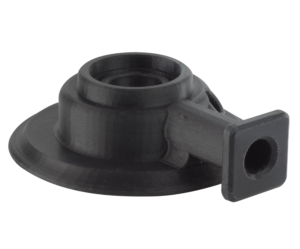 Nylon, or polyamide, is a well-loved material for a wide variety of applications, as it offers numerous benefits that other materials lack. It’s strong and flexible, has good thermal properties, and is resistant to wear and abrasion, just to name a few of its engineering-level qualities. But when it comes to 3D printing, nylon can be problematic. The material has poor dimensional stability and tends to warp quite severely when printed on conventional FFF 3D printers, limiting its use to small or geometrically undemanding parts.
Nylon, or polyamide, is a well-loved material for a wide variety of applications, as it offers numerous benefits that other materials lack. It’s strong and flexible, has good thermal properties, and is resistant to wear and abrasion, just to name a few of its engineering-level qualities. But when it comes to 3D printing, nylon can be problematic. The material has poor dimensional stability and tends to warp quite severely when printed on conventional FFF 3D printers, limiting its use to small or geometrically undemanding parts.
Nylon’s benefits are so many, though, that it can’t be written off as a 3D printing material, so filament manufacturers have been working to develop variations that offer those benefits without the drawbacks. Polymaker has developed what it calls “Warp-Free” technology to make nylon filaments more printable. Warp-Free technology involves fine control of the microstructure and crystallization behavior of nylon materials, allowing full release of the internal stress caused during printing. This results in excellent dimensional stability with almost no warping.
Nylon’s beneficial properties are retained through Warp-Free technology, and no abrasive filler is used so there is little concern about nozzle wear. The first filament created with the technology to be released is PolyMide CoPA, a copolymer drawing qualities from polyamide grade 6 and grade 6,6 which does not require a heated chamber – meaning that it can be 3D printed on any FFF 3D printer with a nozzle temperature of 250°C or higher. PolyMide CoPA is nylon-based and has many of the qualities of nylon, including high heat resistance and strong mechanical properties, making it good for engineering applications.
PolyMide CoPA has a softening temperature of ~180°C, allowing for the 3D printing of working parts or moving assemblies that can withstand high heat or mechanical stress. The filament results in tough parts and isotropic parts that are strong in every direction, thanks to excellent interlayer adhesion.
“We are very excited about the material and the new applications it enables,” said Dr. Xiaofan Luo, CEO of Polymaker. “It further bridges the gap between engineering plastics and desktop 3D printing.”
 PolyMide CoPA can be used in many different industries, especially in automotive, molding and jigs. Recently, a research team at Tongji University used the material to build an eco-car that combined 3D printed nylon parts with carbon fiber panels. Because they could 3D print large parts with custom infill patterns, the team was able to better balance the weight distribution of the car, resulting in better efficiency.
PolyMide CoPA can be used in many different industries, especially in automotive, molding and jigs. Recently, a research team at Tongji University used the material to build an eco-car that combined 3D printed nylon parts with carbon fiber panels. Because they could 3D print large parts with custom infill patterns, the team was able to better balance the weight distribution of the car, resulting in better efficiency.
Another drawback of nylon is that it absorbs moisture quickly, so Polymaker suggests using the PolyBox, a dry storage box designed to keep moisture from getting into filament, maximizing the material’s life and properties.
PolyMide CoPA Black will be released on January 22nd (European customers have access as of the 15th), followed by PolyMide CoPA Natural in March. A spool of PolyMide CoPA Black is $59.99; you can order one here. This isn’t the last material Polymaker will be releasing this year, either – the company has been hard at work and has several other filaments planned for release in 2018.
Discuss this and other 3D printing topics at 3DPrintBoard.com or share your thoughts below.
[Images provided by Polymaker]
Subscribe to Our Email Newsletter
Stay up-to-date on all the latest news from the 3D printing industry and receive information and offers from third party vendors.
You May Also Like
Industrial Giant Ingersoll Rand Leads $19M Round Backing Inkbit’s AI-Driven 3D Printing
Inkbit, the Massachusetts-based original equipment manufacturer (OEM) of multi-material, AI-integrated 3D printers, has closed a $19 million financing round. Ingersoll Rand, a US giant in the industrial equipment sector, led...
3D Printing Unpeeled: Digital FDM Filament for Functional Gradients
Just published in Nature, a paper by a Seoul National University team looks at “3D printing with a 3D printed digital material filament for programming functional gradients.” Sang-Joon Ahn, Howon...
3D Printing Unpeeled: $5000 Cold Spray 3D Printer, Roland DGA & Living Materials
The AeroForge is a $5000 cold spray metal printer for copper made by a student team at Rice University. In a paper for ACS Central Science a team from Nanjing...
3D Printing News Briefs, April 27, 2024: Research, Digital Dentistry, Cycling, & More
We’re starting today’s 3D Printing News Briefs with some research into 3D printed luminescent quantum-dot polymer architectures and free-form laser beam shaping, and then on to an open source 4-axis...

































